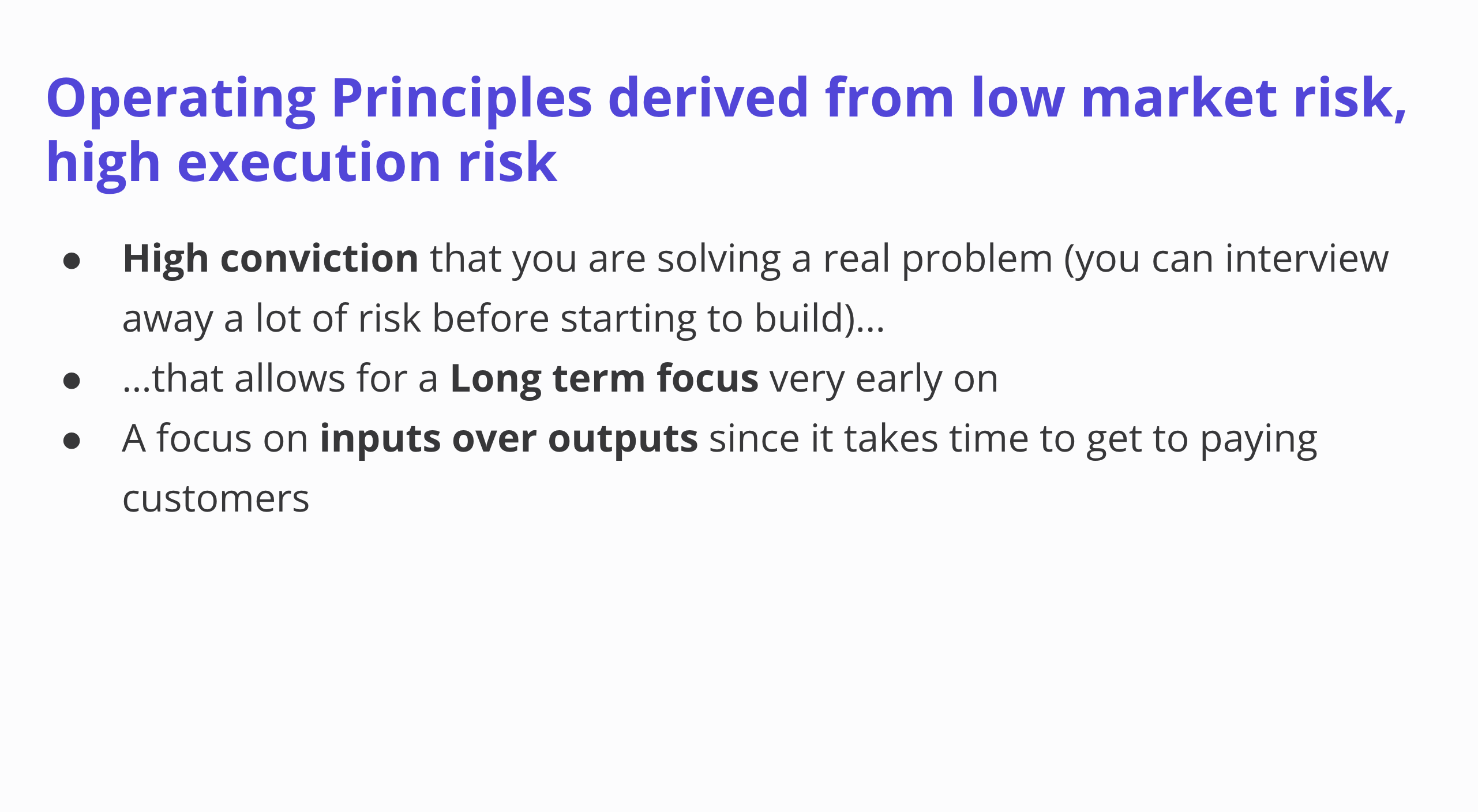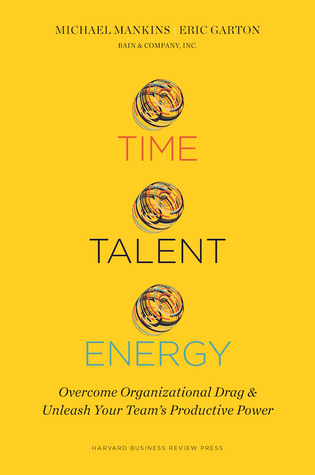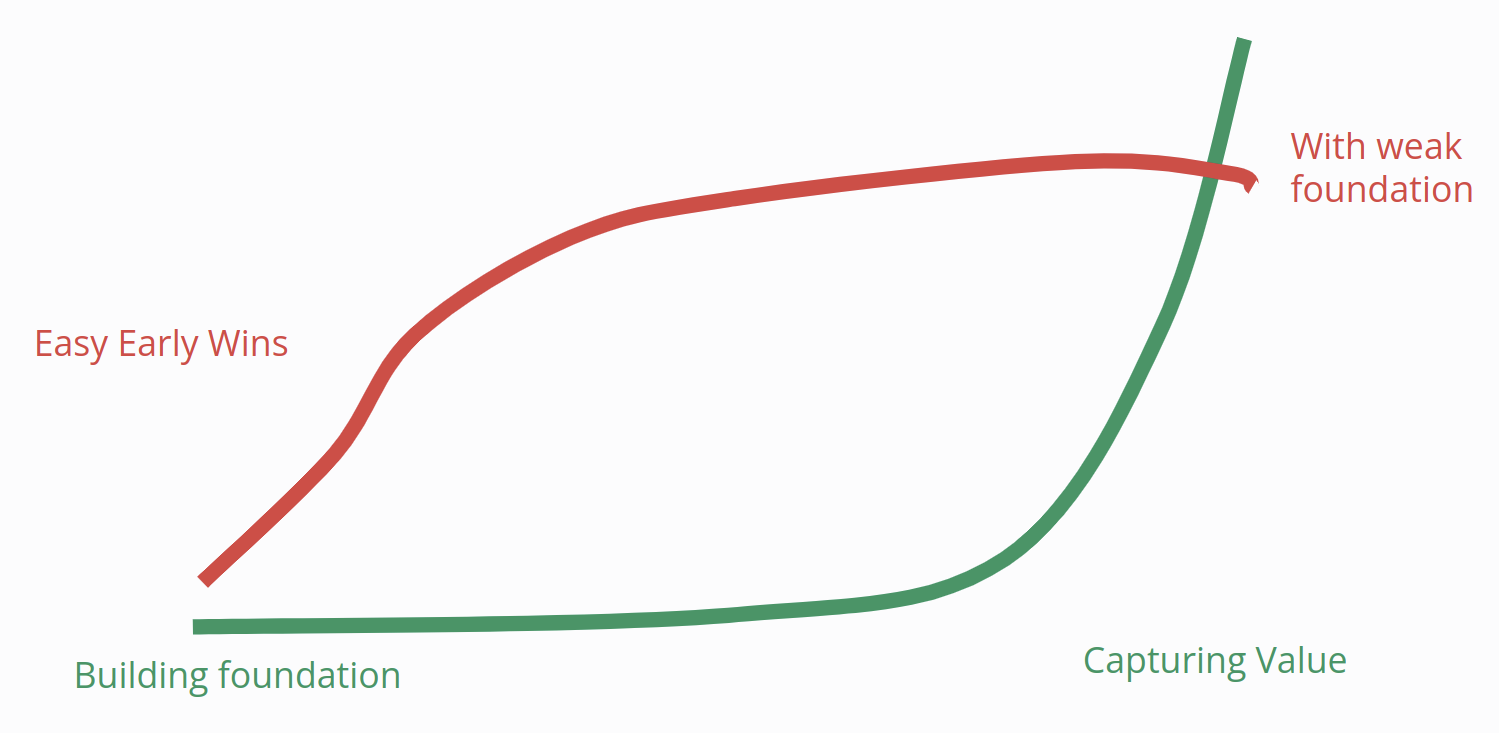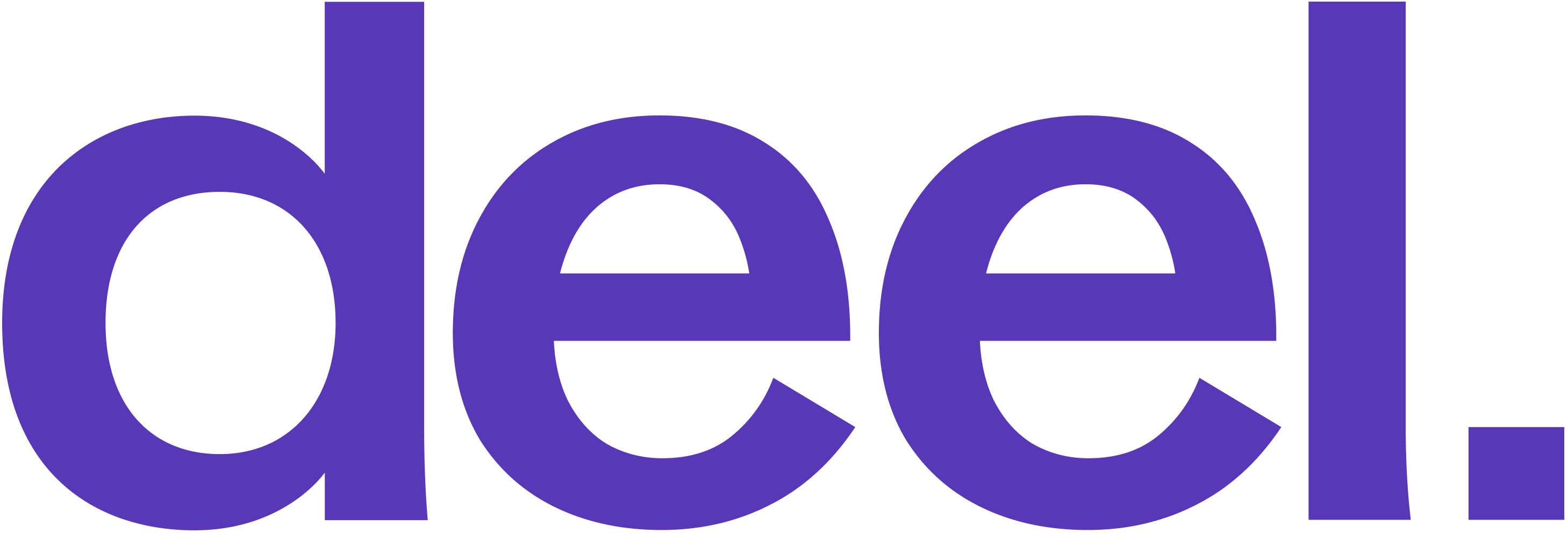Ashby’s Operating Principles
22 minute read
This article was adapted from an internal post I wrote to the team. We consider this a v1 document and expect numerous iterations in future. Earlier documents we’ve published on Ashby’s culture were well received, so we’ll continue to share these in the hopes that they are helpful for the teams you’re building.
This document outlines how we work (operating principles) and what we are looking for in folks on the team (attributes).
The Problem With Values
Many other companies mix operating principles and attributes and call them "values." The problem with "values" is that they end up including things, like "work hard & be nice to people," which are unspecific and free of trade-offs.

Organizations with such superficial values end up not living by them. These values are written down but don't have a material impact on how a company actually operates.
In contrast, operating principles are designed to be specific and oriented around the key inputs to the productivity of our team.
Why Operating Principles Matter
How well an organization executes depends highly on granular behaviors and small decisions that are made by individual team members every day.
Yes, how you manage your calendar has a material impact on how effectively Ashby operates.
This may feel unintuitive, because a lot of thinking about business focuses on grander ideas, such as business strategy. However, if you take a step back, it makes sense that work in organizations gets done by individuals and that the output of the entire organization will be constrained by how these individuals communicate, make decisions, and spend their time.
In short: small details on how we work matter a whole lot. In the absence of operating principles, these details often stay either entirely undefined or are made up by leaders on individual teams, leading to incoherent and often inefficient execution.
By expressing and living by detailed operating principles, we can continue to execute at a significantly higher level of productivity than most teams (which happens to align nicely with our "aim high" operating principle).
The Origin Story
Abhik and I defined the earliest version of our company values when it was just the two of us. A lot of them are still in place today, but not all of them were articulated well and some needed to be added or adjusted over time.
In June 2022, we met in San Diego, CA for a company offsite. The team had grown significantly in the first half of 2022 and Abhik and I wanted to use the chance to refine Ashby's "values" - the first version of Ashby's Operating Principles and Attributes came out of it.
Ashby's operating principles and attributes are a direct result of the kind of company and initial product we aimed to build.
Due to the nature of our original product vision, we knew exactly which market and which customer we were going after from day one. We purposefully picked low market risk (we know exactly what people want) but high execution risk (it is very hard to build), which led to specific initial operating principles you’ll see in the image below.

For example, our long-term focus works particularly well alongside our specific product strategy and is not ideal for many other early-stage startups. While we continue to refine our operating principles and attributes, we do expect the original presentation to provide valuable context long into the future.
While our operating principles and attributes will continue to be refined, we do expect the original presentation to provide valuable context long into the future - but if you want to watch it, you’ll have to join our team first.
Operating Principles
- Apply Principled Thinking Over Experience
- Reflect On And Optimize How You And Your Team Use Your Time
- Apply Thoughtful Communication
- Prioritize Ownership
- Be Frustratingly Patient About Hiring
- Optimize For The Long Term, But, Move With Urgency
- Aim High
- Push For Continuous Improvement
- Care Deeply About Our Customers
- Foster Constructive Debate And Feedback
1 - Apply Principled Thinking (Over Experience)
Summary
- Use past experience as an input, not an output
- Use long-form writing to guide principled thinking
- Avoid lazy thinking by asking yourself multiple “why” questions
- Use an appropriate amount of thought, given the impact (time, money, etc.) the decision will have
Experience should be an input into your thought process, but not a shortcut to avoid thinking.
Our 🧠 defaults to lazy thinking.
Lazy thinking happens when you (unknowingly) make a lot of assumptions and jump to conclusions.
A simple example of lazy thinking: "should we buy billboard ads"?
Someone using "lazy thinking" may arrive at an answer with an argument like below:
- We should buy some billboard ads, everyone is doing that these days.
- We should buy some billboard ads, it worked great at my last company.
These are not good reasons to buy billboard ads. While this is an extreme example, it generally is easy to fall into the trap of lazy thinking and it happens to very intelligent people frequently.
To help avoid lazy thinking, we rely a lot on long-form writing at Ashby. At Ashby, you would write a long-form proposal and it may have the following outline:
Billboard Ad Campaign Proposal
- Why Billboards? ...
- Survey results of audience ...
- Potential markets to test in ...
- Expected outcome ...
Past experience can still be very valuable even when writing up this proposal. For example, someone having run extensive billboard campaigns before may have good insights on how to do attribution well. But again, past experience should be treated as an input into the decision-making process.
Principled Thinking is Not "Analysis Paralysis"
Importantly, principled thinking is not analysis paralysis. When applying principled thinking, you often can make faster decisions because you have strong conviction that your thought process is sound.
Below is a relevant excerpt from a book (with a bad title, and which I don't fully agree with, but that still provides some great insights):
“Never spend a minute quantifying something you know the answer to already, and never spend more than a few minutes quantifying something when there’s a reasonably high probability you know the right answer.” “Most managers demand more data than they need. Superb managers are instinctual, making the right decision most of the time based on limited data.” - Bob Fifer - Double Your Profits in 6 Months or Less
As just one specific example: unlike most of our competition, Ashby provides monthly subscriptions for startups. We did no research on that, it was very evident that customers would want that and what the impact on certain metrics, e.g. retention, would be.
Applying principled thinking does take more time than simply jumping into execution. But in our view, most organizations execute too much and think too little.
2 - Reflect On How You And Your Team Use Your Time - And Optimize For Impact And Leverage
Summary
Time and energy can be wasted by:
- Doing the wrong things
- Doing unnecessary things
- Doing too many things in parallel
- Doing things inefficiently and not creating leverage
- Undisciplined internal communication

Time and energy are the most scarce resources in any organization yet, unlike capital, there is no accounting for it. A good read on this topic is the book Time, Talent, Energy from Bain Company.
How do we spend our time at Ashby? Our time is typically spent on several core activities:
- Talking to customers
- Building (product, content, etc)
- Projects (e.g. operational improvements, changing pricing, etc.)
- Internal communication
One of the easiest ways to waste time is through undisciplined internal communication. Other ways to waste time include:
- Doing the wrong things
- Doing unnecessary things
- Doing too many things in parallel
- Doing things inefficiently
Doing the wrong things
The following could be a huge time sink if principled thinking has not been applied to prioritize them.
- Let’s rewrite our application in insert favorite programming language
- Let’s replace Business System A with Business System B
Doing unnecessary things
It's important to audit how time is used periodically, to make sure no unnecessary work is being done. (This is a great use of Leverage Friday!)
Example: Running a report simply because someone else used to do it:
- A: “I need to spend 5 hours every month generating this report”
- B: “Hmm, are we sure we need it?”
- A: “Well Jane used to do it every end of the month. So I think so…”
Doing too many things at once
It is easy to underestimate your workload and convince yourself that doing multiple things in parallel is a good use of time. Typically, as a team takes on more projects in parallel the amount of overhead to manage projects consumes all available time until the team no longer does any "real work".
Have you ever been in back-to-back status meetings where there was no progress to be reported on the project itself? You were likely operating in a team with lots of parallel projects and therefore too much overhead.
The example below shows that the team running four projects in parallel has 4x as much overhead and is getting far less work done.

Doing things inefficiently
If we see inefficient work that needs to be done over and over again, we aim to fix that (creates leverage which allows us to operate with smaller teams). Examples:
- Operations app tools
- Documentation for Customer Facing Teams in Guru
Having efficiency debt can be acceptable if it’s deliberate and principled thinking was applied.
3 - Apply Thoughtful Communication
Summary
- Internal communication is very expensive (time and energy of everyone you’re communicating with)
- Take that cost seriously and use it to be thoughtful about how you communicate
One of the easiest ways to waste time is through undisciplined internal communication. Communicating thoughtfully is hard. One-to-many communication means there is asymmetry. It’s very easy for a small group of people or an individual to distract a much larger one.
Check out our blog post on How Thoughtful Communication Makes Us Unreasonably Productive.
Here's a Thoughtful Communication cheat sheet:
- Does this need to be communicated?
- Is this the right medium for the type of exchange I need (urgent ping, decision making, requesting feedback on an idea)?
- Is there something we can improve in future to reduce the need to communicate (e.g. frequently repeated questions leads to documentation)?
We are not anti-internal-communication. In fact, strong verbal and written communication is critical for every role at Ashby.
There are fantastic reasons to communicate with other team members in person:
- Communicating meaningful status updates
- Getting feedback on ideas
- Make quick decisions
- Build personal relationships in 1:1s
We just ask you to consider internal communication an expensive currency and to be deliberate about what you spend it on.
4 - Prioritize Ownership
Summary
- As a company, we hire fewer, stronger people and provide them with clear ownership over a specific scope of work
- We trust you to own your work, within your realm of capability
The principle of ownership applies to everyone, from interns to executives. What changes is only the scope.
Within your realm of capability, we trust you to own your work. This entails clearly stating commitments, proactively communicating surprises, being able to understand the context of the work and autonomously making sensible decisions (escalating decisions that mean a larger deviation from committed work). Pulling in help from others where you feel you need it (we value collaboration but in most cases, not consensus-based decision-making).
For your trusted scope of work, we treat you as a black box.
You demonstrate a sense of ownership for the entire organization, not only your team, and therefore seek to have an impact outside of your team when you can be helpful.
Owners don’t need oversight. They still need help from their manager and from their team, but they raise their hand when it’s needed. We strive to build a team of owners.
More Owners = Fewer “Managers” and more “Leaders.”
The number of initiatives a company can run is limited by the number of owners. Adding more non-owners often does not increase productivity.
5 - Be Frustratingly Patient About Hiring
Summary
- "No hire" is better than an "OK hire." The second-order effects of "OK hires" are always underestimated.
- Be very thoughtful when proposing new headcount.
While it can be frustrating to spend many months interviewing for a role, finding the right person is much more advantageous long term. Filling the role quickly and sacrificing quality of hire could have negative second-order effects (i.e. team performance, manager time commitments, etc).
When adding headcount, be very thoughtful and consider the following:
- What exactly will this new person own?
- How will ownership of other people on the team today change?
- If they are a leadership hire - what type of team do they want to build out and are we aligned on that?
In many large companies, employees become protective of what they own because there is not enough work to go around for all. We want to avoid this, which is why we think deliberately about adding new headcount: what are the things we need to do, who owns these things, and if we add new owners, will there be net new projects or will they take things away from existing people?
The ROI of incremental hires tends to trend downwards pretty quickly. The alternative to hiring in these cases is to scratch incremental projects. Note: this doesn’t apply 1-1 for customer facing teams where there are good reasons to hire when capacity constraints are hit.
Obviously, there are great reasons to hire (after all, we're building hiring software!) Just don’t default to new headcount as the solution for all the things!
6 - Optimize For The Long Term, But Move With Urgency
Summary
- Optimizing for the long term is and has been one of our largest competitive advantages.
- Urgency is not rushing. It’s an intense focus on maximizing results per unit of time.
Optimizing for the long-term “just” takes conviction rooted in principled thinking. It “just” takes focusing on inputs over outputs.
It’s hard because most people don’t think and operate this way. You have to accept being misunderstood for a while. Our focus has been on building a strong foundation, and we believe that by doing this we will see much bigger returns and have a more successful business in the long run.

Long-term focus cannot be an excuse for a lack of urgency. You need to pair long-term focus with urgency on near-term inputs. Otherwise, the company will die before taking off.
Urgency is not rushing. It’s an intense focus on maximizing results per unit of time (see principles 2, 3).
Example: Scheduled Dashboards in Ashby Analytics
We were exploring introducing scheduled dashboards to Ashby's Analytics project. The Engineer who led that project found out early into the prototype that this project would take a large amount of time and would consume a lot of our roadmap for that product for the year. The Engineer had the right sense of urgency to flag this as a potential issue and we quickly decided to prioritize other features with higher ROI instead. This resulted in multiple larger product releases that had a bigger impact for customers than scheduled dashboards were expected to have.
7 - Aim High
Summary
- You may miss what you’re aiming for (at first attempt) but typically, the higher you aim the further you go in the long run.
- Aiming high does not mean setting unrealistic goals or deadlines. It does mean carefully considering what “fantastic” would look like and how we might get there.
- The people we like to hire at Ashby like to be ambitious and aim high - it's simply more interesting.
- Industry benchmarks should be paired with principled thinking to see where we can do better.
Aiming high at the company level:
We didn’t set out to build a better ATS; or let alone just a recruiting metrics tool. We picked something big for our long-term vision (Workday). While we are still mostly building an ATS, this changed a lot of our early design decisions (it is very hard to aim higher, later). It’s also simply more fun to be more ambitious (at least for the kind of people we like to work with!)
Aiming high at a project level:
For important projects, consider: how can we do better? It’s a bit cheesy; but thinking “how could this be 10x better” can be a very helpful exercise. Aiming high is a 🧠 trick that can take you out of your comfort zone, consider novel solutions and make you perform much better than you’d believe possible.
Aiming low is mostly a self-fulfilling prophecy. People rarely overachieve what they set out to do.
8 - Implement Continuous Improvement
Summary
- We hold ourselves to a very high standard, which is: there’s always a better way!
You regularly reflect on how you, your team and the entire organization work and you are able to suggest and implement actionable improvements. Implementation is a key part here. Simply suggesting a pile of improvements is of limited value and can be a big source of distractions. You often find yourself thinking: "there must be a better way". You clearly distinguish between very important improvements and nice-to-haves, being well aware that we cannot implement all suggestions.
You seek improvements for yourself and you try to identify how others on your team can improve and how you might be able to help them (mentor and be mentored).
9 - Care Deeply About Our Customers
Summary
- We exist to delight our customers with our products and services.
Our team genuinely cares about our customers! We hire people who get joy out of delighting our customers and feel their pain viscerally when we fail to deliver. This is a good example of an operating principle that has been alive and well but never documented formally.
10 - Foster Constructive Debate and Feedback
Summary
- Seek and provide constructive feedback.
- Do not treat critical feedback as an attack on yourself.
- If needed, "disagree and commit."
This was part of our original values under the title of "Collaboration, Debate, and Open-Mindedness". It didn't make it into the keynote presentation (time crunch), but after further review, we do want this to be its own principle.
🚧 This section is currently the least refined and will be updated in future 🚧
Debates and decision making
Meritocratic debate of ideas is essential for a successful organization. You should default to seeking critical and constructive feedback on your ideas.
You should foster debate at the right time in an initiative. Most debates should happen early-on in the lifetime. Once the initial debate concludes we expect you to disagree and commit. It is easy to derail an entire initiative by side discussions that reheat controversial points which had already been decided upon earlier.
When debating past decisions, they should be judged on the inputs that were available at the time of decision-making, not the eventual result (people often conflate good results with good decision-making and vice versa).
Receiving and providing feedback
You should never treat critical feedback as an attack on yourself. Responding negatively to feedback makes it harder for folks around you to provide it which hinders continuous improvement.
When providing feedback consider the most relevant person to receive it (if you're unsure, your manager can help with this). Our general recommendations:
- If you have feedback about how someone interacted with you, we highly recommend going directly to that person and providing that feedback to them in a timely manner (you can always additionally provide that feedback to a manager at Ashby). If you do not feel comfortable you can speak to your manager or someone else at Ashby first (though we believe this should be very rare in the kind of environment we're building). We will cover a bit more about how we expect folks at Ashby to interact with each other in future.
- If you have feedback about how someone in a different function is operating (e.g. you think you see room for improvement in how someone else is performing their work) it's often times best to provide feedback to your manager or their manager first, since you may not be fully tuned into the expectations for the role. You can say "I saw X do Y and I feel like they should have done Z instead." This kind of feedback is very important, especially as we grow, by providing it to managers they can review how relevant it is and pass coaching along if appropriate
Leaders at Ashby are expected to provide ongoing feedback to their direct reports. But even if you are not in a leadership position providing constructive feedback is highly encouraged.
Team Attributes
While the operating principles above are focused on how we work, the attributes in this section highlight the kind of people we like to work with.
We vet against these attributes when interviewing and they describe how we expect people to "show up" at work.
Humble and Empathetic
All of us can learn from others on the team. No matter what your previous accomplishments are, remain humble and open-minded. For all of your actions, be empathetic and keep in mind how other folks on the team might feel about them. In my experience teams composed of low-ego, highly functional folks produce outstanding results.
Curious
Continuously asking "why" can lead to remarkable insights. If you don't understand, don't be shy to ask. There's a high likelihood that rather than your question being dumb, the explanation being given is poor or wrong. Curiosity and questioning, with a healthy dose of skepticism, can fuel growth for yourself and those around you.
Driven
As highlighted in our operating principles we are building an ambitious organization. Doing that requires hiring folks who are excited about their work and aim for continuous improvement of themselves and their teams (see Operating Principle 8).
Reliable
We hire folks who are very reliable because that is a prerequisite for ownership.
Transparent and Honest
As a default, you should embrace transparency and candid conversations. You should share your work and ideas early and often, allowing others to contribute and improve them.
You should make an effort to share your commitments broadly and discuss your learnings openly if you fail to meet them. High performers have a strong distaste for the hiding of "negative information".
If you have feedback for anyone in the organization, it's your responsibility to share it candidly, and directly with the person in a respectful way.
Don't Take Themselves Too Seriously
It is way easier and more enjoyable to work with people who can laugh about themselves and don't feel like they have to take themselves seriously 100% of the time.
Making It All Work Together
Ten operating principles and six team attributes don't lend themselves to a catchy acronym, and it's unlikely anyone in the company could recite all of them cold. But they work and have an impact because they are actually lived by the team.
Our operating principles are specific enough to impact day-to-day work and decision making. Examples of applying them show up every week when working at Ashby (and especially frequently during onboarding).
When hiring, we a have a strong focus on the attributes outlined above in addition to any job-specific skills & experience.
Most importantly we expect this document to change over time as we learn and grow as a team.



